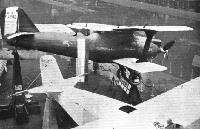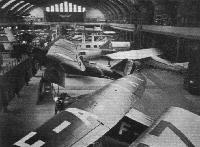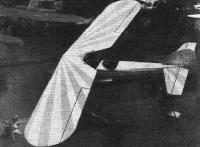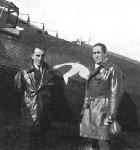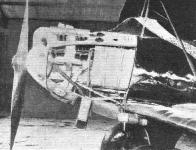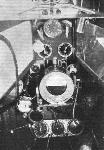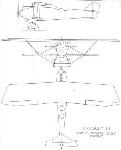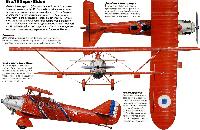Br.19GR Grand Raid / Br.19TF Super Bidon
Bre.19GR: фирма "Breguet", разработав серию вариантов GR (Grand Raid, большой дальности полета), добилась, что Bre.19 оставался в заголовках газет до начала 1930-х годов. Первым появился Bre.19 № 3 с двигателем Lorraine-Dietrich 12Db. Самолет, пилотируемый д'Ойси и Бесином, с топливными баками большей емкости пролетел от Парижа до Шанхая. Bre.19 №64 с дополнительными внутренними топливными баками, управляемый Лемайтре и Аррашаром, в феврале 1925 года установил мировой рекорд, преодолев за два дня расстояние от Этампе до Вилья-Сиснерос в Испанской Сахаре. Бельгия довела до стандарта GR два японских Bre.19, принадлежавших газетному концерну "Асахи Симбун". Летом 1925 года один из них совершил перелет из Токио до Парижа. Было выпущено еще четыре французских GR, на одном из которых установили двигатель Hispano-Suiza 12Lb мощностью 600 л.с. (447 кВт). Этот самолет под названием "Нунжессер-Коли" (имена погибших французских летчиков), пилотируемый Косте и Ле-Бри, совершил с октября 1927 по апрель 1928 года кругосветный полет
Bre.19 Bidon: вариант, ставший логическим продолжением GR. Он строился специально для дальних полетов, имел увеличенный объем внутренних топливных баков и ряд изменений в конструкции фюзеляжа. Первый самолет приобрела Бельгия, а второй установил мировой рекорд, пролетев в мае 1929 года расстояние в 5000 км со средней скоростью 188,1 км/ч. Фирма "Breguet" построила еще два Bidon и один из них продала Китаю. Как минимум один Bidon построила испанская CASA
Bre.19 Super Bidon: финальная версия для достижения максимально возможной дальности. Дополнительные топливные баки размещались в верхнем крыле и в удлиненном фюзеляже. Первая машина строилась для Франции и получила название "Point d'Interrogation". После неудачной попытки трансатлантического перелета на нее установили двигатель Hispano-Suiza 12Lb, с которым самолет за два дня долетел из Ле-Бурже в Маньчжурию, где приземлился 29 сентября 1929 года, установив мировой рекорд перелета по прямой на расстояние 7905 км. В сентябре 1930 года этот же самолет, управляемый Косте и Беллонте, совершил первый беспосадочный перелет Париж - Нью-Йорк. CASA построила еще один Super Bidon, отличавшийся от французского варианта закрытыми кабинами экипажа и дополнительными килями, но он разбился при перелете из Севильи в Латинскую Америку
Показать полностьюShow all
Flight, December 1926
The Paris Aero Show 1926
BREGUET
THE Louis Breguet firm's exhibit at the Salon de l'Aeronautique will consist of three machines: (1) a Breguet 19 G.R. (500 h.p. Hispano-Suiza), holder of the world's straight-line distance record; (2) a Breguet 19 H. distant reconnaissance and bombing seaplane (450 h.p. Lorraine-Dietrich); and (3) a Breguet 26 T six-passenger transport aeroplane (420 h.p. Ghome-Rhone Jupiter).
The Breguet 19 G.R. Distance Record Aeroplane.- This is the type of machine on which the world's straight-away distance record was thrice broken between July 15 and November 1 of this year: first, from Paris to Omsk (Siberia), 4,715 km. in 27 hrs., by Captain Girier and Lieut. Dordilly; second, from Paris to Bunder Abbas (Persia), 5,200 km. in 27 hrs., by Lieut. Challe and Captain Weiser; and third, from Paris to Djask (Persia), 5,400 km. in 32 hrs., by Lieut. Costes and Captain Rignot.
The particular machine shown at the Salon is the one which made the Paris-Omsk and Paris-Djask flights, as well as the record attempt of Costes and Lieut, de Vitrolles from Paris to Assouan (Egypt). It has up to now covered a total distance of more than 40,000 km. (the length of the Equator) without having undergone any repair or change of engine, a 500 h.p. Hispano-Suiza.
The Breguet 19 G.R. differs only in minor particulars from the well-known type 19 A.2 corps observation and 19 B.2 day bombing aeroplanes, of which approximately 1,300 have so far been furnished to the French Military Air Service and several hundred to the Air Forces of Poland, Yugoslavia, Spain and Japan. The framing of the type 19 is entirely of duralumin, pin-jointed and wire braced tubes being used in the fuselage, and built-up, riveted strips in the wing structure. The forward portion of the fuselage is covered with sheet aluminium, while the rear portion, the wings and the tail are fabric-covered.
The type 19 G.R. differs from the military type by having a slightly increased wing area (52-75 sq. m. as against 50 sq. m.), which is obtained by filling in the cut-out of the top wing; fuel tanks of much greater capacity (3,100 litres of petrol and benzol and 200 litres of oil), as a result of which the two cockpits have been removed further aft; and slightly increased tail surfaces. There is one big petrol tank (2,250 litres) just behind the engine; two additional petrol tanks on the sides of the fuselage, and two oil tanks of 100 litres capacity each on either side of the engine.
Equipped for the Paris-Djask flight, the Breguet 19 G.R. had the following weight schedule :-
Weight equipped 1,518 kg.
Weight of crew, food and baggage 250 kg.
Weight of fuel (3,100 litres of petrol and benzol) 2,209 kg.
Weight of oil (200 litres) 180 kg.
Weight, loaded 4,157 kg.
The maximum range of the machine, in still air, was approximately 6,200 km.
<...>
THERE can be no doubt that at the moment the Breguet firm dominates French aviation, and the famous long-distance flights carried out during the past year on Breguet machines give the firm some claim on a leading position within the French aircraft industry. One of the exhibits consisted of a Breguet XIX with 500 h.p. Hispano engine, which has been used in several of the long-distance non-stop flights of the year, and is claimed to have covered no less than 40,000 km
<...>
Показать полностьюShow all
Flight, October 1929
THE FRENCH LONG-DISTANCE RECORD
Some Notes on the Non-Stop Flight of Costes and Bellonte
WE have already briefly reported in FLIGHT the splendid and successful attempt to beat the World's Non-Stop Long-Distance Record by the French airmen, Capts. Costes and Bellonte. This week we give a few further particulars, mainly concerning the Breguet machine used in this flight.
The airmen, it will be remembered, set out from Le Bourget on September 27, and after being reported over Novosimbirsk (3,750 miles from Paris) the following day, nothing more was heard of them for some days. Then came rumours that they had landed in some sparsely populated part of Siberia, and on October 6 the French Consul at Mukden telegraphed that they had made a safe landing, on September 29, about 32 miles north of Tsitsikar, in Manchuria, near the border of Mongolia. The machine was undamaged, but the petrol was exhausted.
On landing, the airmen were arrested by Chinese soldiers, who thought they were Russians and they proceeded to Tsitsikar under guard, arriving there on October 6; they were subsequently released. Costes and Bellonte were 51 hrs. 19 mins. in the air, and the distance flown was about 9,000 km. (5,600 miles), thus easily beating the previous record of 7,188 km. (4,466 miles) accomplished by the Italian pilots, Ferrarin and del Prete, in their flight from Rome to Brazil, in July of 1928.
Costes had announced before starting that he would fly toward the East and endeavour to reach as distant a point as possible, continuing as long as his supply of fuel lasted. His 'plane, the Breguet long-range sesquiplan, "Question Mark," had been specially designed and built this year for such an attempt. It is similar in general lines to the Breguet 'plane built for Costes in 1928, known as the Breguet "Tank Plane." This 1929 machine, however, has a fuel tank capacity of 1,365 gallons (5,780 litres) as compared to that of 1,100 gallons (4,100 litres) of the 1928 'plane. This additional fuel supply increases the flight radius from 5,000 miles to about 6,250 miles.
A centre section, 7 ft. 8 in. wide, has been inserted between the two upper wings, where they come together above the fuselage, thus giving an additional supporting wing surface. The wing gap has been increased 1 ft. 4 in. and the single strut between the upper and lower wings on each side of the fuselage has been replaced by two slanting stream-lined struts. About 3 ft. have been added to the length of the fuselage by increasing the section in front of the pilot. The landing gear has been widened to 8 ft. 10 in., in comparison to 6 ft. 5 in. of the 1928 'plane.
The enlarged fuel tanks have been installed in the wings and in the fuselage. The capacity of the lubricating oil tanks has been increased from 200 litres (52? gallons) to 220 litres (60 gallons). Two additional fuel tanks, having a capacity of 600 litres (160 gallons) each, and well streamlined, have been designed, in addition, to be mounted on the underside of the lower wings under each pair of struts, should it be so desired.
The total weight of the "Question Mark,"' equipped for its long-distance flight, is 6,150 kg. (13,530 lbs.), as compared with the 5,150 kg. (11,330 lbs.) of the 1928 machine.
The "Question Mark" is equipped with a 600-h.p. Hispano-Suiza motor (Solex carburettors) with reduction gear. Carrying a load of 3,260 kg. (7,172 lbs.), this 'plane has shown the following performances :- Maximum speed at 2,000 m. (6,500 ft.), 150 m.p.h. (243 k.p.h.); climb to 5,000 m. (l'6,250 ft.), 26 mins. 54 secs.; theoretical ceiling, 6,700 m. (21,775 ft.).
The fuel consumption tests made recently by Costes have shown that the flight radius of the "Question Mark" is between 9,500 to 10,000 km. (6,000 to 6,250 miles) in a state of no wind prevailing.
Показать полностьюShow all
Flight, September 1930
THE TRANSATLANTIC BREGUET "QUESTION MARK”
Some Notes on the "Long-Distance" Machine of Costes and Bellonte
WE have already recorded (in last week's issue) the fine flight from Paris to New York accomplished by Capt. Costes and Lieut. Bellonte, on September 1-2 – when they covered the 3,700 miles from East to West in 37 hr. 17 min. flying time. Below we give some particulars regarding the machine used for this flight, the Breguet "Grand Raid" or "Long Distance" sesquiplan named Question Mark.
It was on this machine that Costes and Bellonte made the record non-stop flight from France to Manchuria a year ago, and also, we believe, their unsuccessful Atlantic attempt last year. It is a modification, specially for long-distance record flights of the well-known Breguet XIX, with which many famous flights have been accomplished during the past few years. Actually, the Question Mark is a further modification of the "Grand Raid" type, embodying several special features for the flights made by Costes and his companion.
This machine is entirely of metal (duralumin and steel) construction, with fabric covering. The form of the wings and of the tail surfaces differs somewhat, however, from the former Breguets, in the following particulars. The span of the upper wings is a little greater and the gap between the upper and lower wings has been increased, creating a "cabane" by raising the upper wing a little above the fuselage. Two pairs of steel struts, one pair mounted on each side of the fuselage, are used in this latest 'plane as braces between the upper and lower wings, instead of the two single “I" struts used in the previous machines.
The engine is a 650-h.p. Hispano-Suiza type 12 Nb. water-cooled V, fitted with Scintilla magnetos and incidentally it is gratifying to note that British K.L.G. Plugs were used. It has direct drive and is mounted in a neat framework housing with all its accessories, including those of the oil and water circulating systems.
The Wings
The profiles of the upper and lower wings are the same as those of the Breguet type XIX 'plane, of series construction, and the upper surfaces are rounded elliptically at the ends. The two upper wings are joined together by a centre section, having a width of 7 ft. 10 in. into which they are fitted.
The framework of the wing cellule comprises a central "cabane" supported by four stream-lined struts constructed of special steel and reinforced by two oblique rods and four vertical cables. The interplane bracing consists of the same system of guys and cables as that of the series type Breguet XIX.
The Fuselage
Elliptical in cross section, the fuselage is interesting in that the portion in the vicinity of the wing comprises the main fuel tank, which occupies the entire width of the fuselage, the sides of which are formed by the walls of the tank. Immediately behind this are the seats of the pilot and navigator, arranged in tandem.
Each cockpit is well protected by wind shields, and provided with a complete set of controls. The fittings comprise navigation instruments and other facilities suitable for a flight of 40 to 50 hours. The landing gear is composed of two Breguet-type wheels, with 1,000 by 225 mm. Dunlop tyres, mounted on a streamlined axle. Each wheel is covered by streamlined hood.
The Equipment
The equipment consists of the following :- A wireless set, for transmitting and receiving, operated by a retractable generator installed in the side of the fuselage in the navigator's cockpit. The wireless fittings consist of generator, sending key, S.F.R.A.-81 special transmitting and receiving set suitable tor continuous and modulated waves (transmitting 6n 600-700 m. and 800-900 m. wave length; receiving on 450 to 1,550 m.); two 50-watt oscillating valves; etc.
On the right and left sides of the pilot's cockpit and within easy reach of the pilot, the provision lockers are installed. A tank of drinking water, which can be easily detached, is placed under his seat. In front of the pilot and on each side of him are the engine control levers, the petrol taps and the brake of the Gyrorector.
The instruments mounted in the pilot's cockpit are as follows :-
Thermometer to indicate the temperature of the carburettor at different altitudes (i.e., when heated by exhaust gases); two thermometers to indicate the temperature of the mixture entering the carburettor; incline indicator (new model), Aera type; Gyrorector with voltmeter; flight indicator; chronograph; anemometer speed indicator; oil level measuring gauge, type Spirobloc; fuel level measuring gauge for the forward tank, type Spirobloc; fuel level measuring gauge for the rear tank, type Spirobloc; two altimeters; one thermometer for the water temperature; one thermometer for the oil temperature; oil pressure indicator, Amiot type; fuel pressure indicator; Morel horizontal compass, with magnifying lens.
Mounted behind the windshield are an anemometer speed indicator operated by a wind-driven propeller (Wilhelm Morel type), two revolution counters, and a vertical Morel compass.
The fittings in the navigator's cockpit include an inclinometer, Morel compass, recording drift indicator, Alidade bearing indicator, sextant, etc,
Other equipment included a seat-pack type parachute for the pilot and a back-pack parachute for the navigator, while in addition there was provided a pneumatic life-boat, fitted with a pair of oars. This collapsible boat - made of rubber fabric - could be inflated very rapidly by means of a bellows and a bottle of compressed air, and was rolled up and placed in a locker within easy reach of the navigator. A life-buoy inflated in a similar manner, completed the life-saving gear.
Fuel Tanks
The fuel tanks are constructed of riveted sheet duralumin and are of the standard Breguet form and shape. They have a total Capacity of 5,175 litres (1,150 gallons). The main fuel tank, which is installed in the fuselage, consists of two subsidiary tanks, one behind the other. One of these contains 2,990 litres of petrol of -720 specific gravity and the other, which has a capacity of 720 litres (160 gallons), carries a mixture of petrol-benzol having a specific gravity of -780.
A sump, fitted with a "trap" serves both these reservoirs in common. Communication with the first reservoir can be cut off by closing a cock.
Other fuel tanks are installed in the upper wings. They comprise an auxiliary feed tank, of 110 litres (24 gallons) situated in the centre section between the wings, and three tanks situated in each of the upper wings (making six in all). Two of these wing reservoirs have a capacity of 195 litres (43 gallons) each, and the four others carry 240 litres (54 gallons) apiece. These reservoirs are installed between the longerons and their walls form ribs in the wings.
Two other tanks having the form of pontoons were mounted on the under side of the lower wings directly underneath each pair of struts. Each of these tanks had a capacity of 200 litres (44 gallons) and could be emptied by means of a hand pump worked by the navigator. At the last moment, however, before taking off from le Bourget, Costes decided that these additional tanks were not needed and they were removed.
The fuel pump of the motor draws from the sump installed in the large tank of the fuselage; the wing reservoir empties into this large tank. The Solex carburettors are fed directly by the auxiliary feed tank in the wings. The overflow of the auxiliary feed tank empties into the large fuselage tank.
The two reservoirs in the fuselage, comprising the main tank can be emptied instantly by means of two large valves which can then be closed again. The air intakes of the reservoirs in the wings are connected by a piping fitted with cocks and joined to the piping of the large tank. This is done so as to avoid all loss of petrol by siphonnage or evaporation. A cock which closes all the piping connecting these air intakes, assures the absolute water-tightness of these tanks in case the 'plane is forced down on the water.
The lubricating oil circulation system comprises two reservoirs of a total capacity of 220 litres (49 gallons) and a radiator. The water circulation system comprises in addition to the retractable radiator and the usual auxiliary feed tank, a supplementary auxiliary feed tank of 15 litres (3 1/2 gallons) capacity. This latter tank can be connected at will to the water pump, so as to compensate all losses occurring from evaporation during flight.
Показать полностьюShow all







